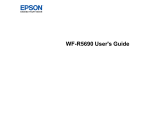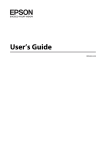Download Ares Chronos FP 110 Instruction manual
Transcript
ULTRA-MICRO Instruction Manual Specifications Length: Height: Main Rotor Diameter: Weight with Battery: Main Motor: Tail Motor: Battery: Transmitter: On-Board Electronics: 6.75 in (171mm) 2.8 in (71mm) 6.6 in (167mm) 1.0 oz (28g) Coreless (installed) Micro-Coreless (installed) 150mAh 1S 3.7V LiPo (included) 5-channel 2.4GHz (included) 4-in-1 control unit Table of Contents Introduction�������������������������������������������������������������������3 Safety Precautions���������������������������������������������������������4 FCC Information�������������������������������������������������������������6 Nanos FP 75 Contents����������������������������������������������������6 Needed to Complete������������������������������������������������������7 Flight Checklist���������������������������������������������������������������8 LiPo Battery Warnings����������������������������������������������������8 Charging LiPo Battery���������������������������������������������������10 Transmitter Details�������������������������������������������������������12 Transmitter Dual Rates.������������������������������������������������12 Flight Controls��������������������������������������������������������������14 Installing Flight Battery.������������������������������������������������16 Initialization�����������������������������������������������������������������17 Trimming in 6-Axis�������������������������������������������������������19 Trimming in 3-Axis�������������������������������������������������������20 Selecting a Flying Site��������������������������������������������������21 Flying (General)������������������������������������������������������������23 Tx/Rx Binding/Linking��������������������������������������������������26 Warranty, Support & Service��������������������������������������27 Replacement Parts List.������������������������������������������������29 Exploded View�������������������������������������������������������������30 2 Introduction Whether you’re looking to advance from your first CX heli or quad, or you're an experienced heli pilot looking for some flying fun around the house, the Ares (air-eez) Nanos FP 75 is the product for you. When flying in stabilized mode, the 6-axis system allows you to fly the Nanos FP 75 comfortably with control similar to that of a CX heli. When you’re ready for a little more flying adventure, just the flip of a switch on your transmitter puts the FP 75 in agility mode so you test your skills making nimble maneuvers you never thought possible. Better yet, if your heli happens to get out of control, just flipping the switch back to the 6-axis system will help you recover and avoid most mishaps that would cause similar helis in the market to end up in a crash! The Ares Nanos FP 75 comes 100% factory-assembled in your choice of 2 attractive, highly visible canopies, and is powered by a coreless motor and a 150mAh 25C battery. Also included are a 5-channel 2.4Ghz transmitter and a power cord that allows you to charge conveniently from the AA transmitter batteries that come with your purchase. With nothing extra to buy, you’ll be flying your Nanos FP 75 around your house within minutes of opening the box! 3 Safety Precautions Failure to use this product in the intended manner as described in the following instruction can result in damage and/or personal injury. A Radio Controlled (RC) airplane/helicopter/quadcopter is not a toy! If misused it can cause serious bodily harm and damage to property. Keep items that could become entangled in the rotor blades away from the rotor blades, including loose clothing, tools, etc. Be especially sure to keep your hands, face and other parts of your body away from the rotor blades. As the user of this product you are solely and wholly responsible for operating it in a manner that does not endanger yourself and others or result in damage to the product or the property of others. This model is controlled by a radio signal that is subject to possible interference from a variety of sources outside your control. This interference can cause momentary loss of control so it is advisable to always keep a safe distance from objects and people in all directions around your model as this will help to avoid collisions and/or injury. 4 • • • • • • Never operate your model if the voltage of the batteries in the transmitter is too low. Always operate your model in an open area away from obstacles, people, vehicles, buildings, etc. Carefully follow the directions and warnings for this and any optional support equipment (chargers, rechargeable batteries, etc.). Keep all chemicals, small parts and all electronic components out of the reach of children. Moisture causes damage to electronic components. Avoid water exposure to all electronic components, parts, etc. not specifically designed and protected for use in water. Never lick or place any portion of the model in your mouth as it could cause serious injury or even death. 5 FCC Information This device complies with part 15 of the FCC rules. Operation is subject to the following two conditions: (1) This device may not cause harmful interference, and (2) this device must accept any interference received, including interference that may cause undesired operation. Caution: Changes or modifications not expressly approved by the party responsible for compliance could void the user’s authority to operate the equipment. This product contains a radio transmitter with wireless technology which has been tested and found to be compliant with the applicable regulations governing a radio transmitter in the 2.400GHz to 2.4835GHz frequency range. The associated regulatory agencies of the following countries recognize the noted certifications for this product as authorized for sale and use: USA Nanos FP 75 Contents Item Description Not Available Separately ........... Nanos FP 75 RTF Airframe AZSH2281 ...................................5-Channel Helicopter Transmitter, 2.4GHz, Mode 2 Not Available Separately ............ AA Batteries (4pcs) AZSH2273 ................................150mAh 1-Cell/1S 3.7V 25C LiPo Battery, Ultra-Micro Connector 6 Needed to Complete The Nanos FP 75 RTF includes everything needed to fly right out of the box. There’s nothing extra to buy or provide! 7 Flight Checklist PLEASE NOTE: This checklist is NOT intended to replace the content included in this instruction manual. Although it can be used as a quick start guide, we strongly suggest reading through this manual completely before proceeding. • Always turn the transmitter on first • Connect the LiPo flight battery to the control unit • Allow the control unit to initialize and arm properly • Fly the model (take-off from a flat/level surface) • Land the model (land on a flat/level surface) • Disconnect the LiPo flight battery from control unit • Always turn the transmitter off last LiPo Battery Warnings IMPORTANT NOTE: Lithium Polymer batteries are significantly more volatile than the alkaline, NiCd or NiMH batteries also used in RC applications. All instructions and warnings must be followed exactly to prevent property damage and/or personal injury as mishandling of LiPo batteries can result in fire. By handling, charging or using the included LiPo battery you assume all risks associated with LiPo batteries. If you do not agree with these conditions please return the complete product in new, unused condition to the place of purchase immediately. 8 • You must charge the LiPo battery in a safe area away from flammable materials. • Never charge the LiPo battery unattended at any time. When charging the battery you should always remain in constant observation to monitor the charging process and react immediately to any potential problems that may occur. • After flying/discharging the battery you must allow it to cool to ambient/room temperature before recharging. • To charge the LiPo battery you must use only the included charge port on the rear of the Transmitter or the optional USB charger available separately. Failure to do so may result in a fire causing property damage and/or personal injury. DO NOT use a NiCd or NiMH charger. • If at any time during the charge or discharge process the battery begins to balloon or swell, discontinue charging or discharging immediately. Quickly and safely disconnect the battery, then place it in a safe, open area away from flammable materials to observe for at least 15 minutes. Continuing to charge or discharge a battery that has begun to balloon or swell can result in a fire. A battery that has ballooned or swollen even a small amount must be removed from service completely. • Store the battery at room temperature, approximately 68–77° Fahrenheit (F), and in a dry area for best results. 9 • When transporting or temporarily storing the battery, the temperature range should be from approximately 40–100°F. Do not store the battery or model in a hot garage, car or direct sunlight whenever possible. If stored in a hot garage or car the battery can be damaged or even catch fire. • Do not over-discharge the LiPo battery. Discharging the LiPo battery too low can cause damage to the battery resulting in reduced power, flight duration or failure of the battery entirely. • LiPo cells should not be discharged to below 3.0V each under load. In the case of the 1-Cell/1S 3.7V LiPo battery used to power the Chronos FP 110, you will not want to allow the battery to fall below 3.0V during flight. • The 4-in-1 control unit has low voltage cutoff (LVC) protection. When the flight battery voltage drops below a set point the LED will begin to blink rapidly and the throttle gradually is reduced. At this point the battery is at about 3.4V and should be recharged. Charging LiPo Battery You must charge the included 150mAh 1-Cell/1S 3.7V 25C LiPo Battery (AZSH2273) using only the charge port on the rear of the Transmitter, the optional USB charger (AZSH2294) or a suitably compatible LiPo battery charger. Charging the LiPo battery using a non-LiPo battery compatible charger (such as a NiCd or NiMH battery charger), or even a different LiPo battery charger with the incorrect settings, may result in damage to the battery or even fire resulting in property damage and/or personal injury. 10 To charge the flight battery, plug the included charge cord into the rear of the transmitter. Plug the battery into the other end of the charge cord. The LED on the front of the transmitter will light green when charging and go out when the battery is charged. Optional USB charger (AZSH2294) To charge the flight battery using the optional USB charger (AZSH2294) plug battery into USB charger and plug charger into USB port on computer. Red LED indicates charging, Green LED lights when battery is charged. NOTE: ENJOY BETTER OVERALL BATTERY PERFORMANCE When charging flight battery from transmitter the batteries in the transmitter are drained fairly quickly leading to decreased flight performance. For best performance order AZSH2294. 11 Transmitter Details The Nanos FP 75 includes a 5-channel Helicopter Transmitter with 2.4GHz technology, stability mode and digital trims. Flight Mode Switch Elevator Trim Throttle Trim (inoperative) Elevator/Aileron Control Stick Throttle/Rudder Control Stick Rudder Trim Aileron Trim (inoperative) ON/OFF Switch Transmitter Dual Rates This helicopter is equipped with a dual rate functionality, which affects maneuverability in 3-axis flight. Please note that 6-axis flight is not affected. The helicopter is set to LOW rates out of the box. This setting optimizes the flying experience for beginner and intermediate pilots, but an advanced pilot may eventually wish to switch to the more maneuverable 12 HIGH rate mode. To toggle the dual rate setting, unplug the helicopter and turn off the transmitter. Then, power on the transmitter and plug the battery in. Quickly move the right stick on the transmitter to bottom left corner and hold it there until the status LED blinks in a short-short-long pattern. This may take 10-20 seconds. Unplug and re-plug the battery on the helicopter, and the status LED will indicate the new rate setting. 13 Flight Controls In the event you are not familiar with the controls of the Nanos FP 75 please take the time to familiarize yourself with them as follows and before proceeding with your first flight: Stick UP to Ascend Stick Down to Descend The left-hand stick on the transmitter controls both the throttle (climb/descend) and rudder (yaw left/right) channels. Moving the stick up increases the speed/RPM of the rotor blades and causes the helicopter to climb. Lowering the stick reduces the speed/RPM and causes the model to descend. Stick Left Nose Yaws Left 14 Stick Right Nose Yaws Right Stick Up Forward Flight Stick Down Backward Flight The right-hand stick controls both the elevator (pitch fore/ aft) and aileron (roll) channels. Pushing the stick forward will pitch the nose of the helicopter downward, allowing it to be flown forward. Pulling the stick down pitches the nose of the helicopter upward, allowing it to be flown backwards. Stick Left Rolls Left Stick Right Rolls Right Moving the right-hand stick to the left will roll the helicopter to the left, allowing it to be flown to the left. Moving the right-hand stick to the right will roll the helicopter to the right, allowing it to be flown to the right. 15 Installing Flight Battery Remove the canopy from the helicopter and install the fully charged flight battery on the hook-and-loop holder with the battery wires facing the front. First turn on the transmitter and then plug the battery into the 4-in-1 controller being careful to maintain correct polarity 16 Initialization To initialize the helicopter, first power on the transmitter and then plug in the battery, replace the canopy, and place the helicopter on the ground, making sure that it is not moving. The LED on the control unit will blink rapidly for three seconds to indicate that the helicopter is in bind mode. Following this, the status LED will turn off while the control unit initializes the radio connection. After a radio connection has been successfully established, the status LED will blink more slowly while the 6-axis gyroscope on the control unit initializes. Gyroscope initialization will not complete until the helicopter has been entirely stationary for roughly five seconds. Once this procedure is finished, the servos on the helicopter will initialize, and the helicopter will be ready for flight. The status LED will either become solid (indicating LOW rate is active) or will blink once per second (indicating that HIGH rate is active). For more information on LOW/HIGH rates, please see the corresponding section of the manual. The 6-axis mode uses state-of-the-art sensing technology to provide stabilized flight that is truly revolutionary for single rotor, flybarless helicopters. In this mode, the position of the cyclic stick commands pitch and roll angles. These angles are limited such that the helicopter will remain stable at all times while still providing fast and maneuverable flight. The helicopter can be brought back to a stable configuration at any time simply by releasing the cyclic stick. The cyclic trim buttons are active in this mode. They can 17 be used to fine tune the neutral pitch and roll angles of the helicopter. If the helicopter has a tendency to move to the right with the cyclic stick centered, left trim should be added, and vice versa. Similarly, if the helicopter has a tendency to move forward with the cyclic stick centered, back trim should be applied. With the trim set correctly, the helicopter is capable of very stable flight with minimal drift. 3-Axis Mode As your skills advance, you may wish to transition to 3-axis mode, which provides more maneuverable flight but is not stabilized and is thereby a little tougher to master. In this mode, the helicopter flies like a high performance traditional flybarless helicopter. Moving the cyclic stick left or right causes the helicopter to roll accordingly, and moving the cyclic stick forward or backward causes the helicopter to pitch forward or backward. There are no angle limits in this mode, so the pilot is free to fly as aggressively as they wish. However, even advanced pilots may sometimes lose control of the aircraft, or they may lose track of its orientation, making a crash likely. In this case, the pilot can simply flip the flight mode switch to the 6-axis position, which will automatically return the helicopter to a neutral orientation, reducing the chance of a crash. This is very useful for low-time pilots who are learning to master flybarless flight, and even advanced pilots may find it useful while learning new maneuvers. Please note that throttle and rudder performance are unaffected by the position of the flight mode switch. 18 Further, the cyclic trim buttons have no effect in 3-axis mode. If corrections are required in this mode, they should be made mechanically by changing the lengths of the pushrods connecting the servo horn to the swashplate. Throttle and rudder trim buttons have no effect in either flight mode. Trimming in 6-Axis If your Nanos FP75 drifts to the side or forward/backward in 6-axis flight, this drift can be eliminated by adding trim using the cyclic trim buttons on the transmitter. If the helicopter is drifting toward the right, the left aileron trim button should be pressed until the drift has been eliminated. On the other hand, if the helicopter drifts to the left, the right aileron trim button should be pressed until the drift has been eliminated. Similarly, if the helicopter drifts forward, the back elevator trim button should be pressed to eliminate this drift, and, if the helicopter drifts backward, the forward elevator trim button should be pressed to eliminate drift. Please note that these trim buttons only affect 6-axis flight. Trimming for 3-axis flight must be done through mechanical trimming, which is described in the following section. The cyclic trim buttons can be zeroed out by pressing both aileron trim buttons at the same time and the pressing both elevator trim buttons at the same time.trim should be added, and vice versa. Similarly, if the helicopter has a tendency to move forward with the cyclic stick centered, back trim should be applied. With the trim set correctly, the helicopter is capable of very stable flight with minimal drift. 19 Trimming in 3-Axis Please note that the helicopter must be in 3-axis mode for mechanical trim, and this trimming should never be performed with the helicopter in 6-axis mode. Any adjustments to 6-axis flight should be achieved by using the cyclic trim buttons on the transmitter. If the helicopter tends to consistently roll or pitch in a particular direction in 3-axis mode, it may be necessary to mechanically trim the helicopter to achieve optimal flight. If the helicopter tends to roll to the right in three-axis mode, the servo pushrods should be adjusted so that the swashplate leans further to the left. To do this, the right pushrod should be lengthened by twisting the plastic piece counterclockwise a number of turns. Then, the left pushrod should be shortened by twisting the plastic piece clockwise the exact same number of turns. If the helicopter tends to roll to the left, the servo pushrods should be adjusted so that the swashplate leans further to the right. To do this, the left pushrod should be lengthened by twisting the plastic piece counterclockwise a number of turns. Then, the right pushrod should be shortened by twisting the plastic piece clockwise the exact same number of turns. If the helicopter tends to pitch forward, the servo pushrods should be adjusted so that the swashplate leans further backward. To do this, both pushrods should be shortened by 20 the same amount by twisting the plastic pieces clockwise the same number of turns. If the helicopter tends to pitch backward, the servo pushrods should be adjusted so that the swashplate leans further forward. To do this, both pushrods should be extended by the same amount by twisting the plastic pieces counterclockwise the same number of turns. Selecting a Flying Site Before proceeding with your first flights indoors or out please be sure to review the details in this section to ensure you’re choosing suitable spaces and conditions to achieve the best possible performance and flying experience. IMPORTANT NOTE: If you are a first-time or low-time pilot we strongly recommend allowing a more experienced pilot to test fly and properly trim the model before attempting your first flight. A proven flyable and properly trimmed model is significantly easier and more enjoyable to fly! Please contact your local hobby shop and/or flying club to find a more experienced pilot near you. Indoor Flying Areas When flying indoors you’ll want to select an open area free of people and obstructions. We suggest an area with at least 12-feet by 12-feet of floor space and no less than 8-foot ceilings when making your first few flights. 21 After you’ve properly trimmed the helicopter and become familiar with its handling and capabilities you may be able to fly in other smaller and less open areas too. However, it’s always more fun to fly indoors in spaces that are larger and/or more open when possible. Outdoor Flying Areas/Conditions When flying outdoors it’s best to fly the Nanos FP 75 at a local park, schoolyard or other area that’s large enough and free of people and obstructions. We also suggest flying over grass as it’s a much more ‘forgiving’ surface that causes less damage in the unfortunate event of a crash. DO NOT fly in parking lots, crowded neighborhood areas or in areas that are not free of people and obstructions. Also, it’s typically best to fly on days that are calm/with no wind, especially when making your first few flights. We strongly suggest flying only in calm conditions until you’re familiar with the controls and handling of the model. Even light winds can make it much more difficult to fly, and in some cases can even carry the model beyond your line of sight. After you’ve properly trimmed the helicopter in calm conditions and become familiar with its handling/capabilities it can be flown outdoors in light wind conditions. Please see the ‘Flying Outdoors’ section of this manual for more information. IMPORTANT NOTE: Do NOT fly on days when significant moisture, such as rain or snow, is present! 22 Flying (General) Now that you’ve selected a suitable flying area you’re ready to fly! And when making your first flights we suggest following these steps: •With the mode switch is 6-axis mode (down) slowly raise the left-hand/throttle stick to increase the speed of the main rotor blades and until the model begins to lift off. Do NOT raise the stick too quickly as the model could climb too fast causing you to lose control and/or make contact with the ceiling or other objects above (this is one of the most common ways for many pilots to crash the first time!). • Lift the model approximately 20–24 inches (50–60 centimeters) off the ground and concentrate on ‘balancing’ the throttle stick position so the helicopter holds a steady hover altitude. It may also be helpful to make a few short ‘hops’ to an altitude of just a few inches until you’re familiar and more comfortable with the control inputs and trim settings required to maintain a steady hover and altitude. However, keep in mind that when only a few inches off the ground you’ll be in ‘ground effect’ which will cause the helicopter to move around more than it typically would at approximately 20–24 inches of altitude. • You’ll find that it sometimes takes minor throttle adjustments to maintain altitude in hover. Remember to keep these adjustments as minimal as possible as large adjustments could result in a loss of control and/or a possible crash. 23 • While attempting to establish a low-level hover out of ground effect (approximately 20–24 inches high or higher) you can check to see if any trim adjustments are required to help keep the helicopter from constantly drifting in various directions. If you find that the helicopter constantly drifts without any directional control input it may be best to land the model before making any adjustments to the trim settings using the trim levers on the transmitter (you can find more information regarding the location and function of the trim in the ‘Flight Controls and Trimming’ section of this manual).z • If the helicopter is drifting forward or backward adjust the elevator trim. • If the entire helicopter is drifting to the left or right adjust the aileron trim. It’s important to continue making trim adjustments as needed until the helicopter can hover at an altitude of approximately 20–24 inches (or higher) with very little drifting or directional control input. And while it’s not possible to eliminate all drifting completely using the trims it is possible to get very close. Also, if this is your first FP (FixedPitch) helicopter model it may be best to enlist the help of an experienced pilot to trim the model for you before making your first flight. • When the helicopter is properly trimmed, maintain a stable hover and practice using the rudder, elevator and aileron controls to get a feel for how the helicopter responds to various control inputs. Remember to keep the control 24 inputs as minimal as possible to prevent over-controlling the helicopter. • Continue to practice until you’re comfortable hovering the helicopter at approximately 20–24 inches of altitude. Then you can transition to hovering the helicopter at higher altitudes of approximately 3–4 feet (0.9–1.2 meters). • If at any time during flight you feel like the helicopter is drifting out of/beyond your control, simply release all of the controls except for throttle. The throttle will be needed to maintain altitude, the stability control in 6-axis mode will return the helicopter to a stable hover. • IN THE UNFORTUNATE EVENT OF A CRASH OR ROTOR BLADE STRIKE, NO MATTER HOW MAJOR OR MINOR, YOU MUST LOWER THE THROTTLE STICK TO THE LOWEST POSSIBLE POSITION AS QUICKLY AS POSSIBLE TO PREVENT DAMAGE TO THE ESCS OF THE CONTROL UNIT. If you do not lower the throttle stick to the lowest possible position in the event of a crash/rotor blade strike it can result in damage to the ESCs of the control unit which may require replacement of the control unit. NOTE: Crash damage is not covered under warranty. 25 Tx/Rx Binding/Linking Binding/linking is the process of programming the receiver to recognize the Globally Unique Identifier (GUID) code of a single specific transmitter. These steps outline the binding/ linking process of the 5-Channel Helicopter Transmitter (AZSH2281) and receiver/control unit in the Nanos FP 75 Press this button while turning on Tx Start by plugging in your fully charged battery to the 4-in-1 unit. You will notice a red blinking LED as soon as you plug in the flight battery. While the LED is blinking, hold down the right rudder trim button while turning on the transmitter. When the red LED goes out you may release the right rudder trim button and you should hear the servos center. This indicates that you are now linked. Test the controls by moving the right stick, making sure you have servo movement. Once the control test has been done your FP75 is ready for flight 26 Warranty, Support & Service 30-Day Limited Warranty Term Period: We warranty that the Product(s) purchased (the “Product”) will be free from defects in materials and workmanship when the product is new (before being used) for the limited warranty term period, 30 days, from the date of purchase by the Purchaser. If you believe a defect in material, workmanship, etc. was not apparent when the Product was new and only became evident after the Product was used, take the following steps. If you purchased the Product at a HobbyTown store, please contact your local HobbyTown store for warranty support and/ or service. If you purchased the Product from the Firelands website, use the contact information found under the Support heading to contact Firelands directly. If you contact Firelands, you may be asked to send the product to Firelands, at your cost, for inspection. Provided the warranty conditions have been met within the warranty term period, the components that are found to be defective, incorrectly manufactured or assembled may be repaired or replaced, at the sole discretion of Firelands. Your warranty item will be returned to you at Firelands’ expense. In the event your product needs repair or a replacement part that is not covered by this warranty, your local HobbyTown store or Firelands can assist you with support and in obtaining the genuine replacement parts to repair your Product. Firelands will charge $40.00 per hour plus the cost of replacement parts to service your vehicle if after contacting you, you so authorize such repairs. Your product 27 will be returned to you at your expense. If you purchased your Product from a HobbyTown Internet site not affiliated with a local store, please consult that site for its support and service policies. You can also find more information at: www.Hobbytown.com by emailing [email protected] or call 800-205-6773 28 Replacement Parts List Ref # Item # Description Not Shown AZSH2200 Nanos FP 75 RTF Micro Heli 18 AZSH2206 Main Board: Nanos FP 75 27 AZSH2207L Left Servo: Nanos FP 75 14 AZSH2207R Right Servo: Nanos FP 75 23 AZSH2219 Main Gear; Nanos FP 75 2 AZSH2227 Main Rotor Grip Set: Nanos FP 75 1 AZSH2229 Main Blade Set: Nanos FP 75 Not Shown AZSH2231 Complete Hardware Set: Nanos FP 75 21 AZSH2234 Landing Gear Set: Nanos FP 75 29 AZSH2238 Vertical Stabilizer: Nanos FP 75 32 AZSH2239 Tail Rotor: Nanos FP 75 13 AZSH2247 Servo Linkage (2): Nanos FP 75 7 AZSH2259 Push Rod Set (2): Nanos FP 75 20 AZSH2271R Red Canopy: Nanos FP 75 20 AZSH2271B Blue Canopy: Nanos FP 75 17 AZSH2273 1S 3.7V 150mAh 25C Battery: Nanos FP 75 15 AZSH2276 Coreless Main Motor: Nanos FP 75 Not Shown AZSH2281 Transmitter: Nanos FP 75 11 AZSH2291 Main Shaft Bearing Set (2): Nanos FP 75 Not Shown AZSH2294 USB Charger: Nanos FP 75 4,6,8,9 AZSH2298 Main Shaft Assembly w/Swash Plate & Head Block 12,28,30,31 AZSH2299 Main Frame Assembly w/Tail Boom, Motor & Vertical Stab 29 Exploded View 30 31 www.Ares-RC.com © 2014 32
































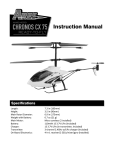
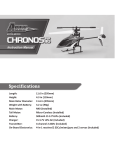
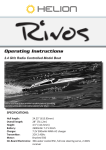
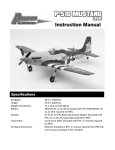
![新商品の特徴[PDF]](http://vs1.manualzilla.com/store/data/006596589_2-ecd314527c2d1908952de85e6d557b1f-150x150.png)
